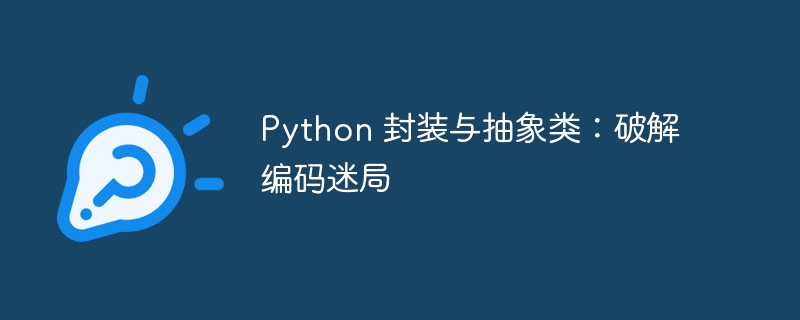

python Encapsulation and abstract classes are the basic concepts of Object-oriented programming## (OOP) and are used to organize and manage code to improve code readability, reusability and maintainability.
EncapsulationEncapsulation is a technique that hides implementation details and exposes only necessary interfaces. In
Python, encapsulation is implemented using private properties and methods. Private properties and methods begin with a double underscore (__) and are accessible only to the class and its subclasses.
Enhance the code
class Person: def __init__(self, name): self.__age = 0# Private property self.name = name def get_age(self): return self.__age def set_age(self, age): if age < 0: raise ValueError("Age cannot be negative") self.__age = age
Abstract class is a base class that defines a set of concrete methods and abstract methods. Concrete methods are implemented in the base class, while abstract methods are only declared but not implemented. Abstract methods must be implemented in derived classes.
use:Define a common interface for subclasses.
Use
Must use the abc module as the base class.
Derived classes must implement all abstract methods, otherwise
from abc import ABCMeta, abstractmethod class Shape(metaclass=ABCMeta): @abstractmethod def get_area(self): class Rectangle(Shape): def __init__(self, length, width): self.length = length self.width = width def get_area(self): return self.length * self.width
Encapsulation and abstract classes can be used together to improve code organization and maintainability. An abstract class defines a public interface, while encapsulation hides the internal state of the class and exposes only the necessary interfaces. This prevents external code from directly accessing internal state, while still allowing subclasses to access and modify that state.
advantage:Enhance code security: Hide sensitive data through encapsulation.
Python's encapsulation and abstract classes are powerful
toolsfor building flexible, reusable, and maintainable code. By hiding implementation details and defining public interfaces, they can help organize code, reduce coupling, and improve the overall quality of the code.
The above is the detailed content of Python encapsulation and abstract classes: cracking the coding puzzle. For more information, please follow other related articles on the PHP Chinese website!
 What programs can be developed with php
What programs can be developed with php
 0x80070002 solution
0x80070002 solution
 Today's Toutiao gold coin is equal to 1 yuan
Today's Toutiao gold coin is equal to 1 yuan
 How to solve the problem that win11 antivirus software cannot be opened
How to solve the problem that win11 antivirus software cannot be opened
 What does formatting a mobile phone mean?
What does formatting a mobile phone mean?
 How to embed CSS styles in HTML
How to embed CSS styles in HTML
 vscode
vscode
 What should I do if the Chinese restart setting of vscode does not take effect?
What should I do if the Chinese restart setting of vscode does not take effect?




